
Over-discharge
When a 12V lead acid battery is discharged until voltage drops to lower than 2.1V and the electrolyte density drops to lower than 1.18g/ml, and then it is called over-discharge. If it starts the over-discharge stage, the battery terminal voltage will drop rapidly, which will easily lead to interruption of power supply. This leads to excessive consumption of active materials, resulting in the reduction of active material pores and the reaction area reserved for the next charging, resulting in the difficulty of subsequent charging and maintenance of the battery, and ultimately causing the battery to be unable to be fully charged and the capacity to drop significantly.
Reason
1. The charger is damaged
2. The battery vent is blocked
3. The overtime discharge
Solution
The peak voltage of the protection voltage is set in the BMS; the batteries are placed in strict accordance with the placement spacing, and if necessary, the battery can be covered with materials to improve the overcharge resistance of the battery; during the discharge process, the discharge voltage, current, electrolyte density, and liquid temperature should be checked regularly. Wait for the data, analyze and determine the depth of discharge, and charge in time.

Overcharge
In the early stage of charging of ordinary lead-acid batteries, the battery terminal voltage is relatively low. When the battery terminal voltage rises to a certain value, the battery will release a large amount of gas. When the battery terminal voltage rises to 2.30-2.35VPC (this voltage is called the gas point voltage), the gas in the battery increases significantly. As the charging progresses, the PbO2 on the surface of the electrode becomes more and more, while the PbSO4 has gradually decreased, the oxygen evolution rate of the positive electrode will increase, and at the same time, the negative electrode of the battery begins to slowly evolve hydrogen. Therefore, overcharging will cause a large amount of gas in the battery, so that the UPS battery loses water and causes premature failure and shortens its life.
Reason
1. The battery voltage is discharged from 24V to a voltage below 21V;
2. 1~2 days and nights after the discharge is over, it is not charged in time;
3. Electrolyte mixed impurities;
4. Plate vulcanization
Solution
When the voltage and the density of the electrolyte reach the maximum value, after the normal charging is completed, the current half of the 10h discharge rate is used to continue charging, and the voltage and the density of the electrolyte are observed every hour. If there is no change after 4 consecutive observations, the overcharging can be stopped when air bubbles appear around the plate.
Powered & Powerful!
Distributors and OEM business are warmly welcome.
Get connected with professional lead acid Battery manufacturer,
sales@gembattery.com
WhatsApp: +8615959276199